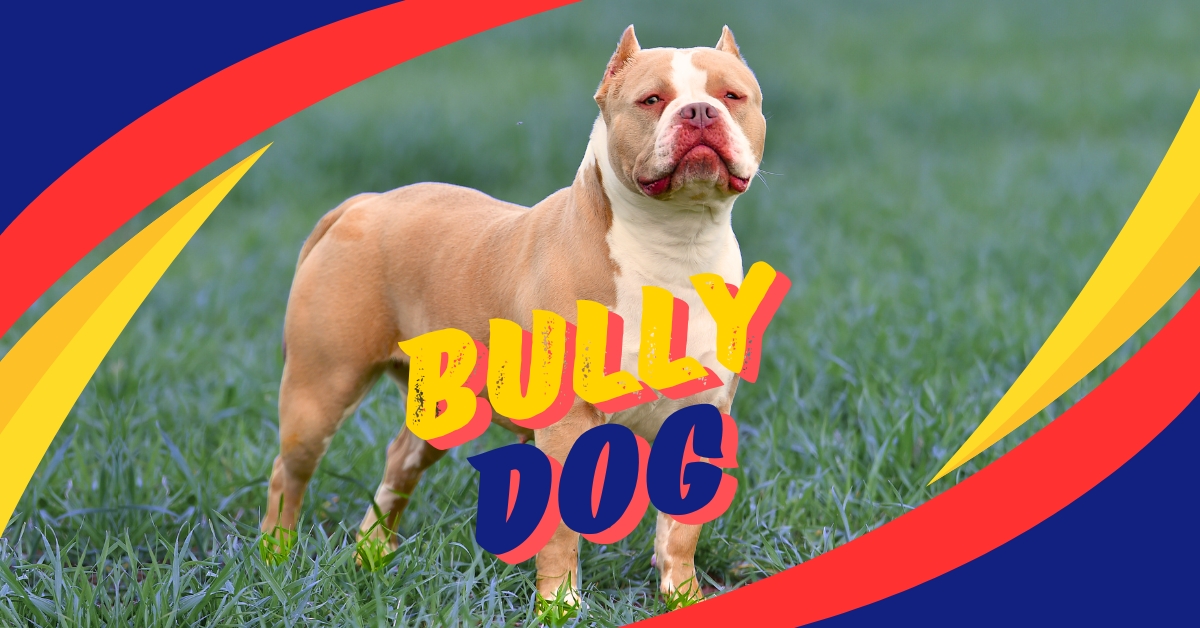Bully dogs are some of the most misunderstood and misrepresented breeds in the canine world. Known for their muscular builds, strong jaws, and confident demeanor, these dogs are often unfairly labeled as aggressive. However, when raised in a loving environment with proper care and training, They can be some of the most loyal and affectionate pets
But what is a Bully dog, exactly? This guide will dive into the world of Bully dog breeds, explaining their origins, temperaments, and what you can expect when owning one. From caring for their specific needs to understanding their health issues, we’ll cover everything you need to know. Whether you’re considering adopting a Bully dog or already have one, this article will provide valuable insights into raising a well-behaved, healthy, and happy Bully.
1. What is a Bully Dog? Understanding the Origins and Breeds
They are a group of breeds that originated from molosser-type dogs, known for their muscular bodies, broad heads, and strong jaws. These dogs were initially bred for various purposes, including herding, guarding, and even bull-baiting—a practice that eventually led to their name. Over time, many Bully breeds were selectively bred to be companions and working dogs, with more focus on temperament and loyalty than aggression.
Common Bully dog breeds include:
- American Bully: Developed in the 1990s, the American Bully is a mix of American Pit Bull Terrier, American Bulldog, and other Bully breeds. They are known for their muscular build and friendly demeanor, making them excellent companions.
- American Pit Bull Terrier: Perhaps the most well-known of the Bully breeds, the Pit Bull is often misunderstood due to its history in dogfighting. However, they are intelligent, loyal, and affectionate dogs when raised in a loving environment.
- English Bulldog: Stocky and wrinkled, the English Bulldog is a less active Bully breed but makes a great family pet due to its calm and gentle nature.
- Staffordshire Bull Terrier: The “Staffy” is known for its stocky build and courage. Despite its tough exterior, Staffordshire Bull Terriers are affectionate and great with children.
The term “Bully dog” covers a wide variety of breeds, each with unique traits. Whether you’re looking for a family companion or a working dog, there is a Bully breed suited to your lifestyle.
2. Different Types of Bully Dogs: From American Bully to Pit Bulls
The term “Bully dog” encompasses several different breeds, each with distinct characteristics and purposes. Here are some of the most popular types of Bully dogs:
- American Bully: The American Bully is a relatively new breed, developed in the United States in the 1990s. Bred as a companion dog, they are muscular and confident but tend to be gentle and social, making them great family pets. They come in various sizes, from Pocket to XL varieties.
- American Pit Bull Terrier: Often confused with the American Bully, the American Pit Bull Terrier is an older breed with roots in bull-baiting and farm work. While they are athletic and strong, they can be very affectionate when properly trained and socialized.
- English Bulldog: Known for their unique appearance with wrinkled faces and stout builds, English Bulldogs are calmer than some of their Bully counterparts. They were originally bred for bull-baiting but now are known for their laid-back and loving nature.
- American Bulldog: Larger than the English Bulldog, American Bulldogs are powerful and athletic. They were originally bred for farm work and protection but are also great as loyal, protective companions.
- Staffordshire Bull Terrier: Often referred to as the “Nanny Dog” due to their love for children, Staffies are small but sturdy dogs that thrive in family settings. They are affectionate, intelligent, and highly trainable.
Each of this dog breed has its unique traits, but they share a common ancestry in molosser-type dogs, known for their strength and loyalty. Understanding the differences between these breeds can help you choose the right Bully for your household.
3. Bully Dog Temperament: What to Expect
One of the biggest misconceptions about Bully dogs is that they are naturally aggressive. In reality, Bully breeds are known for their loyalty, intelligence, and affectionate nature when raised in the right environment. Their temperament can vary depending on their breed, upbringing, and training, but most they are social, protective, and great with families.
Here’s what you can expect from the temperament of a Bully dog:
- Loyalty: Bully breeds are incredibly loyal to their owners and families. They form strong bonds with their humans and are often protective, making them excellent guard dogs.
- Affectionate nature: Despite their tough appearance, they are known for being affectionate and loving. They enjoy being around people, including children, and are often referred to as “lap dogs” because of their desire for closeness.
- Confidence: they are confident and courageous. While they can be independent, they respond well to leadership and are eager to please their owners.
- Playfulness: Many Bully breeds are playful and energetic, especially when young. They love interactive games and exercise, making them great companions for active families.
However, without proper socialization and training, they can become overly protective or develop aggressive tendencies. That’s why early training, positive reinforcement, and consistent leadership are essential for ensuring a well-balanced Bully dog. With the right care, they can make loving, loyal, and gentle family pets.
But before we dive deeper, have you ever noticed that adorable dog side eye your furry friend gives you? It’s not just cute; it actually holds significant meaning! To explore the fascinating reasons behind this behavior, check out our detailed guide on 8 Incredible Reasons Behind Dog Side Eye: What It Means for Your Furry Friend.
4. Caring for a Bully Dog: Nutrition, Exercise, and Grooming
Taking care of a dog requires attention to their specific dietary, exercise, and grooming needs to keep them healthy and happy. Here’s a complete guide to caring for a Bully dog:
- Nutrition: Bully dogs are muscular and energetic, which means they need a high-protein diet to support their growth and muscle maintenance. Look for dog food that lists meat as the first ingredient and contains essential nutrients like omega fatty acids, which support their coat and skin health. Avoid foods with fillers like corn or soy, which provide little nutritional value.
- Exercise: Bully breeds tend to have high energy levels, especially during their younger years. Regular exercise is crucial to keep them mentally stimulated and physically fit. Daily walks, playtime, and interactive toys can help burn off excess energy and prevent behavioral issues. Some Bully breeds, like the American Bully, love activities like agility training and tug-of-war.
- Grooming: Despite their short coats, they require regular grooming to keep their skin and coat healthy. Brushing your Bully dog a few times a week helps remove loose hair and prevents skin irritation. Additionally, pay attention to cleaning their ears and wrinkles (especially for Bulldogs), as these areas can be prone to infections.
- Health check-ups: Regular vet visits are essential to ensure your Bully dog is up to date on vaccinations, heartworm prevention, and flea treatments. Bully breeds are prone to certain health issues, so regular check-ups help catch any problems early.
By providing a balanced diet, regular exercise, and grooming, you can ensure that your Bully dog stays healthy and happy for years to come.
5. Training a Bully Dog: Tips for Raising a Well-Behaved Pet
Training a this breed is essential for raising a well-behaved and balanced pet. While Bully breeds are known for their loyalty and intelligence, they can also be strong-willed and independent. Early socialization and consistent training are key to shaping their behavior.
Here are some tips for training your Bully dog:
- Start early: The best time to begin training a Bully dog is during puppyhood. Early socialization with people, other animals, and new environments helps prevent fear-based aggression and builds confidence.
- Positive reinforcement: Bully breeds respond best to positive reinforcement methods, such as treats, praise, and play. Avoid harsh punishment or negative reinforcement, as this can lead to fear and aggression. Rewarding good behavior encourages your Bully dog to repeat those actions.
- Set boundaries: they are confident and can sometimes be stubborn, so it’s important to set clear boundaries early on. Teach basic commands like sit, stay, and come to establish structure and leadership.
- Consistency is key: Consistency in training helps reinforce good behavior. Stick to a regular routine and use the same commands and rewards to avoid confusion. Consistent rules will help your dog understand what is expected of them.
- Address problem behaviors early: If you notice any undesirable behaviors, such as jumping, chewing, or barking, address them immediately before they become ingrained. Redirect your dog’s attention to appropriate behavior and reward them for obeying.
By investing time and effort into training, you can raise a well-behaved Bully dog who is confident, obedient, and a joy to be around.
Conclusion
Bully dogs are strong, loyal, and affectionate companions that can make excellent family pets when properly raised and trained. While they are often misunderstood due to their muscular appearance and historical background, these breeds thrive in loving environments and are known for their loyalty and playful nature.
In this guide, we’ve explored everything from the origins of Bully dog breeds to their temperament, care, training, and common health concerns. By understanding the unique needs of Bully dogs, you can provide the best care for your pet, ensuring they live a happy and healthy life.
Whether you’re considering adopting a Bully dog or already have one, remember that with the right training and attention, these powerful dogs can be gentle, loving, and well-behaved members of your family.
FAQs
- What is a Bully dog?
A term used to describe a group of dog breeds that descend from molosser-type dogs. These breeds are characterized by their muscular build, broad heads, and strong jaws. Common Bully dog breeds include the American Bully, Pit Bull, English Bulldog, and Staffordshire Bull Terrier. - Are Bully dogs aggressive?
No, they are not naturally aggressive. Like any other breed, their temperament depends on proper training, socialization, and how they are raised. With the right care, Bully dogs are loyal, affectionate, and friendly pets. - Are Bully dogs good family pets?
Yes, Bully dogs can make excellent family pets. They are known for their loyalty, protective nature, and affection toward family members, including children. Early training and socialization are key to ensuring they are well-behaved. - What are the different types of Bully dogs?
Some of the most popular Bully dog breeds include the American Bully, American Pit Bull Terrier, English Bulldog, American Bulldog, and Staffordshire Bull Terrier. Each breed has unique traits but shares a common ancestry. - What is the temperament of a Bully dog?
They are typically loyal, confident, and affectionate. They form strong bonds with their families and are often protective. Despite their muscular appearance, many Bully dogs are gentle and playful, especially with proper training and socialization. - How much exercise does a Bully dog need?
They are energetic and require regular exercise to stay healthy and happy. Daily walks, playtime, and mental stimulation are essential to prevent boredom and destructive behaviors. - What health issues are common in Bully dogs?
Common health issues in Bully breeds include hip dysplasia, brachycephalic airway syndrome (in flat-faced breeds like Bulldogs), skin allergies, and heart conditions. Regular vet visits and preventive care can help manage these risks. - Do Bully dogs need special grooming?
They have short coats, making grooming relatively easy. Weekly brushing helps remove loose hair and prevent skin irritations. Special attention should be given to cleaning their ears and skin folds (in Bulldogs) to avoid infections. - Are Bully dogs easy to train?
Yes, with the right approach, They can be trained effectively. They respond well to positive reinforcement methods, such as treats and praise. Consistency in training and early socialization are crucial for shaping good behavior. - What should I feed a Bully dog?
Bully dogs require a high-protein diet to support their muscular build and energy levels. Feeding them high-quality dog food with meat as the primary ingredient will ensure they get the nutrients they need for optimal health.

Joseph Bush is a seasoned writer and researcher with over 7 years of experience covering a wide range of general topics, from lifestyle and technology to business and current events. He is dedicated to producing fact-checked, reader-friendly content that informs, engages, and empowers readers.
Throughout his career, Joseph has followed strict editorial guidelines, relied on reputable sources, and ensured every article meets the highest standards of accuracy and clarity. His expertise spans multiple fields, allowing him to explain complex topics in a way that’s easy to understand.
Passionate about continuous learning, Joseph stays updated on industry trends and best practices to deliver trustworthy, well-rounded insights. Readers can rely on his work for its credibility, depth, and real-world relevance.




